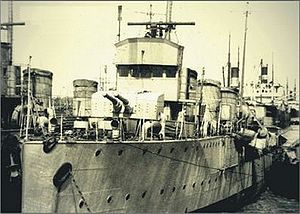- Mărăşti class destroyer
-

NMS MărăştiClass overview Operators:  Regia Marina
Regia Marina
 Romanian Naval Forces
Romanian Naval Forces
 Soviet Navy
Soviet Navy
 Spanish Navy
Spanish NavySucceeded by: Regele Ferdinand class destroyer Completed: 4 Retired: 4 General characteristics Type: Destroyer Displacement: 1,410 long tons (1,430 t) standard
1,723 long tons (1,751 t) full loadLength: 94.18 m (309 ft 0 in) Beam: 9.47 m (31 ft 1 in) Draught: 3.5 m (11 ft 6 in) Propulsion: 2 shaft Tosi type geared turbines, 5 Thornycroft type boilers, 45,000 hp Speed: 34 knots (39 mph; 63 km/h) Range: 1700 nm at 15 knots Complement: 139 Armament: (as modernised for Romania)
-
- 5×120 mm guns (2x2, 1x1)
•4×76 mm guns (4x1)
• 2×13 mm machine guns
•4×18 in (457 mm) torpedo tubes (2×2)
• 30 mines
- 5×120 mm guns (2x2, 1x1)
The Mărăști class were a group of destroyers built in Italy for the Romanian Navy. The ships fought in both world wars but for different owners and had a complex history.
Contents
History
In 1913, the Romanian government ordered a class of four large destroyers from the Pattison yard in Naples, Italy. The four ships were named Vifor, Viscol, Vârtej and Vijelia. The Italian government requisitioned the ships in 1915 upon entering World War I, renaming them Aquila, Falco, Nibbio and Sparviero. These ships were significantly larger than contemporary Italian destroyers and were rated as Esploratori or scouts. The armament comprised three single 6 inch and 4 x 3 inch guns.
After the end of the First World War, two of the ships (Sparviero and Nibbio) were re-sold to Romania, arriving in Constanţa in 1920. The other two ships were retained by Italy until sold to the Nationalist faction of Spain in 1937. The six inch guns proved too heavy for the Romanian Navy and were replaced by two twin 120 mm guns in powered turrets and a single 120 mm gun.
Both ships were active during the Naval war in the Black Sea in World War II. Chiefly convoying supplies between Romania, the Crimea and the Bosphorus. Măraşeşti sank the Soviet M class submarine M-31 in July 1943. Both ships were surrendered to the Soviets in August 1944 on the Capitulation of Romania and were incorporated into the Black Sea Fleet as the Lovkiy (Ловкий, ex-Mărăşti) and Lyogkiy (Лёгкий, ex-Mărăşeşti) but were returned to Romania in October 1945, served in Naval Forces of Romanian People's Republic under the numbers D12 and D11 and scrapped in the 1960s.
Aquila and Falco were sold to the Nationalist Spanish Navy , which, in 1937 only had one destroyer available (Velasco). They were renamed Melilla and Ceuta, and saw heavy service, in spite of their poor condition. To conceal the fact that Italy was selling ships to Franco's side, they were often referred as Velasco-Ceuta and Velasco-Melilla. After the war, they were retained by the Spanish Navy.
Ships
Ship Launched Commissioned Fate Mărăşti (ex Sparviero, ex Vijelia) 26 March 1917 15 July 1917 Deleted 1963 Mărăşeşti (ex Nibbio, ex Vârtej) 30 January 1918 15 May 1918 Deleted 1963 The former Aquila and Falco served in the Spanish Navy as Melilla and Ceuta until 1949
Name
Name in Italian Service
Builder
Launched
Transferred to Spain
Decommissioned
Fate
Melilla
Aquila Patison - Naples 1916 1937 1950 Scrapped Ceuta
Falco Patison - Naples 1919 1937 1948 Scrapped See also
References
- Whitley, M.J. (1988). Destroyers of World War 2. Cassell Publishing. ISBN 1-85409-521-8.
- Conway's All the World's Fighting Ships 1922-1946
Categories:- Destroyer classes
- World War II destroyers of Romania
- World War II destroyers of the Soviet Union
- Romania–Soviet Union relations
-
Wikimedia Foundation. 2010.

